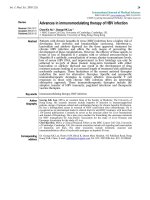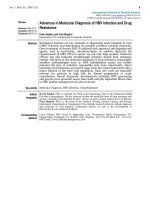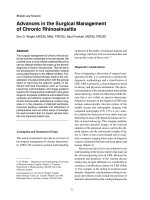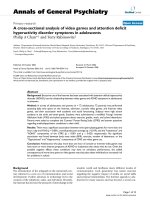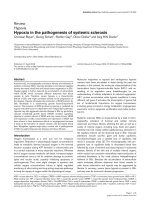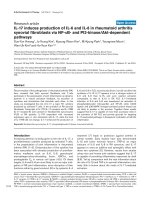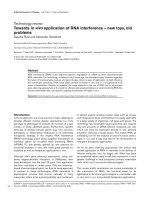Báo cáo y học: "Advances in Molecular Diagnosis of HBV Infection and Drug Resistance"
Bạn đang xem bản rút gọn của tài liệu. Xem và tải ngay bản đầy đủ của tài liệu tại đây (634.29 KB, 9 trang )
Int. J. Med. Sci. 2005 2(1)
8
International Journal of Medical Sciences
ISSN 1449-1907 www.medsci.org 2005 2(1):8-16
©2005 Ivyspring International Publisher. All rights reserved
Advances in Molecular Diagnosis of HBV Infection and Drug
Resistance
Review
Received: 2004.10.01
Accepted: 2005.01.02
Published:2005.01.05
Erwin Sablon and Fred Shapiro
Innogenetics NV, Industriepark Zwijnaarde, Belgium
A
A
b
b
s
s
t
t
r
r
a
a
c
c
t
t
Serological markers are key elements in diagnosing acute hepatitis B virus
(HBV) infection and determining its possible evolution towards chronicity.
Once treatment of chronic HBV is initiated with approved anti-hepadnaviral
agents, such as lamivudine, interferon-alpha, or adefovir dipivoxil, the
measurement of HBV DNA in serum can not only help monitor treatment
efficacy but also indicates breakthrough infection should drug resistance
emerge. Advances in the molecular diagnosis of drug resistance using highly
sensitive methodologies such as DNA hybridization assays can further
pinpoint the type of mutation responsible and, more importantly, detect
upcoming viral resistance at an early stage when the variant represents only a
minor fraction of the total viral population. Such new tools are especially
relevant for patients at high risk for disease progression or acute
exacerbation. Recent diagnostic developments including HBV genotyping
and precore/core promoter assays that could well play important future roles
in HBV patient management are also reviewed.
K
K
e
e
y
y
w
w
o
o
r
r
d
d
s
s
Molecular Diagnosis, HBV Infection, Drug Resistance
A
A
u
u
t
t
h
h
o
o
r
r
b
b
i
i
o
o
g
g
r
r
a
a
p
p
h
h
y
y
Erwin Sablon, PhD, is currently the Head of the Hepatology Unit, in the Diagnostics R&D
Division at Innogenetics. His key interests include the molecular basis of drug resistance and
genetic variability of the hepatitis B and C viruses, as well as serum markers for liver fibrosis.
Fred Shapiro, MLS, is the Head of the Medical Writing, Science Editing, and Science
Information Departments at Innogenetics. His principle research interests include diagnosis
and treatment of viral hepatitis, Alzheimer's disease, as well as the development of
theranostics for personalized medicine.
C
C
o
o
r
r
r
r
e
e
s
s
p
p
o
o
n
n
d
d
i
i
n
n
g
g
a
a
d
d
d
d
r
r
e
e
s
s
s
s
Erwin Sablon, PhD, Head of Hepatology Unit, Theranostics R&D, Innogenetics NV,
Industriepark Zwijnaarde 7/4, B-9052 Gent, Belgium. Tel.:32-9-241-0804 Fax.: 32-9-241-
0907Email:
Int. J. Med. Sci. 2005 2(1)
9
1. From Acute to Chronic HBV Disease
When hepatitis B virus (HBV) infection is suspected, it is the appearance of serum markers of HBV infection that establishes
the diagnosis of the disease. Of these, HBsAg is considered to be the sentinel marker for the confirmation of acute infection. Its
presence can be detected as early as 6 weeks after exposure, and should therefore be assessed when prodromal (malaise, anorexia,
fever, rash, arthralgia) or more classical symptoms (dark urine, jaundice) are observed. Generally, some 8 to 16 weeks will usually
have elapsed from exposure to the virus until the appearance of telltale symptoms. HBsAg is also the key marker in determining
whether hepatitis B infection has become chronic: defined as the persistence of the surface antigen for at least 6 months [1]. By
contrast, if acute disease resolves, HBsAg declines followed by a subsequent rise of antibodies to the surface antigen (anti-HBs)
upon recovery (Figure 1).
Serum HBV DNA and HBeAg are two other key markers appearing precociously, and are indicative of active viral replication.
The former may be present at levels exceeding 10
5
to 10
6
copies/mL and can be identified some 6-12 weeks after exposure to the
virus, or even earlier if PCR-based methods are used. During acute infection, HBeAg and transaminase levels are also elevated. As
the immune system begins to mount its response to infection, an initial rise - then decline - of anti-HBc IgM, is observed. By
contrast, anti-HBc IgG rises but persists even after acute infection has resolved. As HBV viremia is cleared, anti-HBe also begins to
increase, and alanine aminotransferase (ALT) levels decline [2].
Of the two billion persons worldwide who come into contact with HBV, approximately 6% of the global population (more than
350 million persons) fail to resolve acute viral infection and become chronic carriers, eventually placing between 15% to 25% of
such individuals at risk for end-stage liver disease. Should chronic carriage ensue, those persons who are unable to resolve HBV
infection enter into a low replication phase of infection marked by the seroconversion of HBeAg to anti-HBe. This change occurs in
about 10% (5%-20%) of chronic adult carriers per year [3]. The inactive carrier state is marked by continued HBsAg positivity, in
contrast to a drop in HBV DNA levels to less than 10
5
copies/mL. In addition, ALT levels and anti-HBc IgM decline and normalize;
liver histology shows a significant reduction in necro-inflammation. Sometimes the passage to this phase is marked by a flare-up in
disease activity termed seroconversion illness [2]. Repeated episodes of active hepatitis may occur until final anti-HBe
seroconversion materializes.
This classical course of events may be confounded by several exceptions. For instance, core promoter or precore mutations lead
to HBV variants that either drastically curtail or abolish HBeAg production, respectively. As seroconversion to anti-HBe progresses
(ie HBeAg-expressing variants are eliminated immunologically, while precore variants escape detection, survive, and increase),
circulating levels of HBV DNA remain high and liver disease persists or relapses [4].
Moreover, the age when infection is acquired markedly influences the course of disease. Three predominant patterns have been
noted: (i) early (perinatal) infection – especially prevalent in Asia and Oceania – characterized by a long immune tolerant phase
(high serum HBV DNA, persistent HBeAg positivity, normal ALT, poor response to therapy); (ii) person-to-person HBV
transmission in childhood frequently observed in sub-Saharan Africa, the Mediterranean countries, and Alaska where such children
exhibit HBeAg-positivity, elevated ALT, and peripubertal seroconversion to anti-HBe; and (iii) acquisition of HBV during
adulthood as often happens among persons in Western countries with an absence of immune tolerance, a relatively rapid progression
to immune clearance, and a better response to therapy [1].
2. Relevance and Utility of HBV DNA Detection Methods
Although HBV DNA assays are not presently recommended for the routine evaluation and management of patients with
chronic HBV infections, they nevertheless provide very useful adjunct information concerning viral replication – especially in
situations when patient serological profiles fall outside of classical patterns. Some key advantages and disadvantages of HBV DNA
testing are presented in Table 1.
Current HBV DNA assays make use of differing technologies and can generally be divided into (i) signal amplification assays
(liquid phase hybridization, antibody capture approach, branched DNA) and (ii) DNA amplification tests based on the polymerase
chain reaction (PCR) [for detailed reviews, see 2,5]. Signal amplification assays have sensitivities approaching 1 pg of DNA (10
5
-
10
6
genome copies) or even to 10
3
genome copies [2]. Alternatively, HBV DNA detection based on a nested PCR approach can
detect as few as 10
2
-10
3
genome copies. At such low titers, problems with contamination and reproducibility may lead to false-
positive results, thereby necessitating the use of internal or external standards [5]. Commercial assays that make use of semi-
automated systems can overcome these limitations [2,5].
In contrast to PCR tests that measure HBV DNA titers only after completion of the PCR cycle (‘endpoint measurement’), real-
time PCR technology, based on continuous quantitative monitoring during the exponential phase of the PCR reaction, is able to
measure viral loads over a larger dynamic range [2,5]. New developments (TaqMan technology, molecular beacons) that decrease
the number of handling steps, reduce contamination, and increase throughput and the accuracy of quantification will further enhance
the utility of these assays [2,5].
Given the varied technologies used to determine HBV DNA titers, it is understandable that considerable variation in results
may occur when using different viral load tests. This makes standardization of HBV DNA viral load assays an important issue that is
yet to be resolved [2]. Collaborative studies have been undertaken to establish international standards for HBV DNA nucleic acid
amplification techniques [5,6], but no clear consensus has yet emerged. Finally, the role of viral load testing to detect drug resistance
is discussed below.
3. HBV Treatment Options and Drug Resistance
For the 350 million persons chronically infected with HBV, the two therapeutic approaches presently available to control
infection and its sequelae are immunomodulatory agents and/or antiviral chemotherapy. Such treatments aim at interrupting the
progression and clinical outcomes of the disease (cirrhosis, hepatocellular carcinoma) by stimulating the anti-HBV-specific host
immune response or by markedly decreasing viral replication.
Int. J. Med. Sci. 2005 2(1)
10
The first therapeutic agent to be approved for hepatitis B was interferon-alpha (IFN-α), whose dual mode of action includes
both antiviral and immunomodulatory effects. Unfortunately, extended IFN-α treatment is expensive, injection-dependent, effective
in no more than 15-25% of patients, and associated with a wide spectrum of adverse reactions [7]. These limitations will be partially
obviated by the likely approval of peginterferon-alpha for use in chronic HBV. One recent phase 2, dose-ranging study indicated that
the once-weekly dose of this agent resulted in a two-fold higher response rate (HBeAg seroconversion; HBV suppression, ALT
normalization) after six months of treatment compared to conventional interferon, although the frequencies of adverse events were
similar [8].
However, it is the nucleoside analogue lamivudine that has become the gold standard worldwide for use in patients with chronic
hepatitis B. The convenience of its relatively affordable cost, a one-pill-per-day regimen, and the low incidence of side effects has
made it the preferred treatment for many patients. Nevertheless, despite a good safety profile and initial efficacy, lamivudine-
induced decreases in viral load are difficult to sustain over time due to the occurrence of viral drug resistance. Thus, the antiviral
effects of the drug are gradually reversed in most cases. The ensuing rebound effect [9,10] is termed breakthrough infection. It is
now known that genotypic resistance to lamivudine emerges in approximately one quarter of patients after one year of treatment [11-
13], rising to more than 40% after two years, and increasing further to over 50% and 70% after years three and four, respectively
[13]. Increasing the drug dosage does not appear to substantially affect the rate at which viral resistance occurs [11].
The armamentarium of HBV therapy has recently been expanded by the approval of the nucleotide analog, adefovir dipivoxil.
Its antiviral efficacy was confirmed in large-scale clinical trials for the therapy of both HBeAg-positive [14] and HBeAg-negative
[15] chronic hepatitis B, achieving more than a 3-log decrease in viral load, a significant drop in serum ALT levels, and an
improvement in liver histology after one to two years of therapy. Although resistance surveillance in adefovir-treated patients for
potential resistance mutations until 48 weeks [16] and then up to 60 weeks [17] did not reveal the emergence of resistant mutants,
this did not turn out to be the case upon treatment after 96 weeks [18]. Just as is the present case for lamivudine, resistance testing
for adefovir mutations could become necessary should the rate of emergence of resistance and the impact of such mutations turn out
to be clinically relevant for therapy management.
4. Molecular Mechanisms of Drug Resistance
HBV is a small but elusive DNA virus that presents relatively few specific targets for antiviral interventions. At present, the
target of choice is the HBV polymerase protein – an enzyme that plays an essential role in viral replication [19]. Within its four
functional regions (Figure 2), drug resistance to lamivudine is associated with mutations in the very conserved catalytic polymerase
/reverse transcriptase domain of the gene [20], located specifically at a locus of four amino acids consisting of tyrosine-methionine-
aspartate-aspartate, termed the YMDD motif [21]. It is thought that lamivudine acts here by suppressing HBV replication. Given that
HBV generates up to 10
12
virions/day [22], and because of the selective pressure exerted by long-term administration of lamivudine
on the virus, HBV mutants emerge.
When mutations occur, the configuration of the wild-type YMDD motif becomes altered in such a way that the drug no longer
successfully exerts its inhibitory action at that site. Both wild-type and resistance virus strains then populate the infected liver. HBV
DNA and ALT levels usually begin to rebound, but are generally lower compared to baseline levels when only wild-type virus is
present.
Three key mutations in the polymerase gene have been shown to confer resistance to lamivudine and adefovir dipivoxil (Figure
2), although many other mutations have also been described [19]. With respect to the recently adopted nomenclature for HBV
mutations in the polymerase region [23], the first two include the substitution of methionine (M) by the amino acids isoleucine (I) or
valine (V) in the YMDD motif (C domain) at position rtM204V/I. In the majority of cases, these mutations in the YMDD motif
occur together with an additional compensatory mutation in the B subdomain [20], namely the substitution of a leucine by
methionine some 20 amino acids upstream from the YMDD domain at position rtL180M. Finally, the newly discovered mutant to
adefovir (rtN236T) is located downstream from the YMDD motif in the D domain of the viral polymerase.
Assuming correct patient compliance with treatment, resistance to antiviral therapy is presently defined as (i) an increase in
serum HBV DNA titers during therapy after a sustained viral response and (ii) the selection of a mutation in the viral polymerase
gene (YMDD motif of the polymerase C domain) that could not be detected in the major viral species prior to therapy, and that is
not included in the HBV consensus sequences from data banks (i.e., genotypic resistance) [24].
5. Monitoring HBV Drug Resistance
Several options are currently available to monitor HBV drug resistance, and can generally be divided into genotypic assays and
phenotypic methods. The former detect changes in the HBV genomic sequence in the course of treatment. In addition, indirect
measures of lamivudine resistance including determination of ALT values, and especially HBV DNA (viral load) assays are
routinely used in the clinic. A comparison of these methods is presented in Table 2.
(1) Genotyping Methods
Direct DNA Sequencing
Standard DNA sequencing technology provides highly accurate and complete DNA sequence information, and is applicable to
any part of the 3.2-kilobase HBV genome [25]. A serious handicap is the inability of sequencing to detect viral resistance even when
the mutated virus still makes up a relatively large fraction (up to 30%) of the entire HBV population (i.e., mixtures of wild-type and
mutant species). This limits its use for detecting upcoming resistance at an early stage [26]. Furthermore, it tends to be time-
consuming and labor intensive, not readily adaptable to high-throughput screening, and is amenable to analysis only by well-trained
personnel.
Int. J. Med. Sci. 2005 2(1)
11
Clonal Analysis
An additional difficulty when using direct DNA sequencing of a PCR product is to know whether a given set of mutations
occurs on the same molecule or in a different clonal subpopulation. This obstacle can theoretically be circumvented by sequencing
multiple clones from a given sample. But unless a sufficient amount of clones are analyzed, minor subpopulations may remain
undetected [20,27]. The technique is quite laborious, and is not adaptable for large-scale use.
RFLP
This methodology provides a means of overcoming some of the aforementioned limitations. RFLP methodology is as accurate
as direct DNA sequencing [28] but, unlike sequencing, can detect samples with mixed virus populations containing mutant virus
making up 5% to 10% of the virus population [29,30]. Nevertheless, the procedure is generally long and tedious (multiple PCRs,
multiple enzyme digestions), and requires skilled personnel since a specific endonuclease reaction has to be developed for each
separate mutation to be analyzed. Such tests tend to be ‘home brews,’ and have not been commercialized for general use [28,31].
DNA Hybridization
Various types of assays exist that make use of probe-product hybrids. For instance, fluorometric real-time PCR with the
LightCycler Assay can be used to detect resistant variants. Samples differing by only one nucleotide can be readily distinguished
[32,33]. However, natural sequence variability in places where the fluorescence probes bind can lead to a lower melting temperature
of the probe without necessarily being associated with a resistance mutation. Moreover, for unequivocal detection of lamivudine
resistance, the variant subpopulation may have to comprise at least 5% to 10% of the total [33]. Another test that employs mixed
hybridization-sequencing-PCR (“minisequencing”) technology involves the extension of multiple oligonucleotide primers with
fluorescent ddNTPs by means of a DNA polymerase [34].
An alternative approach involves differential hybridization to a preexisting panel of membrane-bound probes as illustrated by
the commercially available INNO-LiPA HBV DR line probe assay (Figure 3). The test makes use of a series of short immobilized
oligonucleotide probes to discriminate between different nucleic acid fragments (down to single nucleotide mismatches), thereby
enabling identification of wild-type or mutant variants [23,26]. Importantly, the test can detect variations early during the emergence
of viral resistance even when the variant represents only a minor fraction of the total viral population [26,35]. This is especially
relevant for patients at high risk for disease progression. An example of the monitoring and early detection of HBV drug resistance
with this test is shown in Figure 4. In the consecutive patient samples presented, the YIDD mutation (rtM204I) was detected about
40 weeks after the start of lamivudine therapy, some 10 and twelve weeks before the increases in viral load and ALT, respectively.
Subsequently, the YIDD mutation was replaced by a YVDD mutant. This latter mutation was seen to persist (over 40 weeks) after
lamivudine treatment was halted.
The limitation of such hybridization-based methods (melting curve analysis, line probe assays) lies in their single-base
discrimination. Specificity can be influenced by the sequences neighboring a polymorphic site, or by possible interference from
secondary structures [36]. Furthermore, as new mutations arise, such hybridization-based assays must be updated accordingly.
Recent Developments
Possible future methods for detection of resistance could make use of technologies such as fluorescence (relying on secondary
reporter systems) [37,38] or matrix-assisted laser desorption/ionization time-of-flight mass spectrometry (MALDI-TOF-MS)
[39,40]. They offer a highly sensitive means to detect unidentified HBV variants – even when comprising only a small percentage of
wild-type/mutant mixtures. While fast and accurate, these methods require the use of well-trained technicians and expensive
equipment, and have not been optimized for high-throughput use.
Oligonucleotide Microarrays
Microchip-based tests can also be envisaged for HBV resistance testing, as they may be well suited for the study of multiple
mutations on the same genome [41]. However, as the number of clinically relevant mutants is presently relatively limited, the
development of microarray-based assays for HBV resistance will probably not be cost effective unless combined with other tests.
(2) Indirect Methods
Quantification of HBV DNA (viral load assays)
Aside from its role as a ‘baseline’ indicator of HBV infectivity, the measurement of viral load is an indispensable means for
monitoring and confirming resistance to lamivudine therapy. Indeed, resistance to antivirals is still generally defined clinically by a
rise in serum HBV DNA levels during antiviral therapy.
Although HBV DNA assays will eventually detect changes in viral load as a consequence of emerging resistance to lamivudine
(see further), other factors (e.g., compliance) may also be responsible for alterations in HBV DNA levels. Therefore, viral load
measurements and changes in ALT titers should, by themselves, not be solely relied upon as indicators of viral resistance now that
specific genotyping tests for drug resistance are available. Moreover, when a given mutation represents only a minor fraction of the
total viral population, viral load will only be proportionately affected, and will rise with a variable delay with respect to the onset
and progression of resistance (Figure 4). Therefore, the combined use of a genotyping assay for polymerase mutant detection and
quantitative detection of viremia with a highly sensitive assay is warranted for optimal monitoring of HBV antiviral therapy [42,43].
Int. J. Med. Sci. 2005 2(1)
12
(3) Phenotyping Methods
These methods detect drug resistance based on the use of molecular or cellular techniques or using animal models [20]. Such
systems are useful for studying HBV replication, cellular accumulation of covalently closed circular DNA, and for characterizing
HBV mutants. However, their use is labor-intensive and not amenable to high-throughput testing or commercialization.
6. Management of HBV Drug Resistance
Given the recent approval of adefovir dipivoxil, and the probability that other antivirals could also become available in the not-
too-distant future, the management of drug resistance must now be seen within a broadening and evolving clinical context.
Moreover, it is increasingly apparent that clinically relevant prediction and monitoring of viral resistance may not only require the
use of existing tools such as drug resistance and viral load testing, but might also have to be extended to include the detection of
mutations in the precore and core promoter regions as well as HBV genotyping. This is because recent studies have, for instance,
shown that patients with precore mutants who develop lamivudine resistance may have a higher risk for severe exacerbation of liver
disease [44,45]. This is especially worrying since chronic HBV patients harbouring precore mutants generally require long-term
therapy. Numerous studies also indicate strong associations between certain viral genotypes that influence mutational patterns in the
precore/core promoter regions responsible for either abolishing or diminishing HBeAg production [46,47].
7. Clinical Impact of Hepatitis B Genotypes
For a DNA virus, the HBV genome shows an exceptional degree of molecular variation (incorporation of some 10
10
mistaken
nucleotides into the HBV virion per day [21]). Over time, this spontaneous tendency for mutations has led to the emergence of at
least seven HBV genotypes (designated A to G), defined by a divergence of 8% or more with reference to the complete nucleotide
sequence. These different genotypes show a distinct geographic distribution: genotype A is found in northern Europe, the United
States, and Central Africa; B and C predominate in Asia; D is associated with southern Europe, the Middle East, and India; E is
uniquely African; and F is found in Central and South America as well as in Polynesia [48,49]. Genotype G has recently been
localized in the United States and France [50], while a putative eighth genotype H has also been discovered in Central America [51].
The study of possible clinical ramifications of HBV genotypes is the subject of intense clinical research, with evidence accumulating
that HBV genotyping influences the natural history and severity of liver disease, HBeAg seroconversion rates, precore/core
promoter mutational patterns, and response to treatment (Table 3). Its determination – just as is the case for hepatitis C – could well
emerge as an important consideration in the clinical evaluation of HBV patients prior to treatment.
8. Research Directions
Advances in HBV diagnostic testing have fortuitously paralleled the advent of new, effective drugs for HBV that have already
been, or will soon be approved in the near future. These new assays - combined with classical diagnostic methods - will help
determine the best long-term treatment strategies (sequential, combined, etc.) for the use of such new drugs. At the same time, a key
challenge is the integration of HBV diagnostic testing with new therapeutic agents in order to ensure optimized, tailored patient
treatment. Such integrated HBV diagnostic and treatment strategies will undoubtedly have to be adapted to economic imperatives
and epidemiological realities (geographic patterns and modes of transmission). For instance, this implies differing testing-treatment
schemes depending on whether high-incidence, less affluent regions or low-incidence, high-affluent areas are being targeted.
Whatever the strategies that emerge, both classical HBV serological tests and advanced molecular diagnostics will be used together
to monitor therapeutic efficacy and ensure cost-effectiveness.
Conflict of interest
Erwin Sablon and Fred Shapiro both work for Innogenetics NV.
References
1. Lok ASF, McMahon BJ. Chronic hepatitis B. Hepatology 2001;34:1225-1241.
2. Bowden S. Laboratory diagnosis of hepatitis B infection. In: Lai CL, Locarnini S, eds. Hepatitis B Virus. London, UK: International Medical
Press. 2002:145-159.
3. Hoofnagle JH, Dusheiko GM, Seef LB, et al. Seroconversion from hepatitis B e antigen to antibody in chronic type B hepatitis. Ann Intern
Med 1981;94:744-748.
4. Davis GL. Update on the management of chronic hepatitis B. Rev Gastroenterol Disord 2002;2:106-115.
5. Schutten M, Niesters HGM. Clinical utility of viral quantification as a tool for disease monitoring. Exp Rev Mol Diagn 2001;1:153-162.
6. Saldanha J, Gerlich W, Lelie N, Dawson P, Heermann K, Heath A. An international collaborative study to establish a World Health
Organization international standard for hepatitis B virus DNA nucleic acid amplification techniques. Vox Sang 2001;80:63-71.
7. Conjeevaram HS, Lok ASF. Management of chronic hepatitis B. J Hepatol 2003;38 (suppl 1):S90-S103.
8. Dienstag JL, Perrillo RP, Schiff ER, Bartholomew M, Vicary C, Rubin M. A preliminary trial of lamivudine for chronic hepatitis B infection.
New Engl J Med 1995;333:1657-1661.
9. Lai CL, Ching CK, Tung AK, Li E, Young J, Hill A, et al. Lamivudine is effective in suppressing hepatitis B virus DNA in Chinese hepatitis
B surface antigen carriers: a placebo-controlled trial. Hepatology 1997;25:241-244.
10. Cooksley WGE, Piratvisuth T, Lee S-D, Mahachai V, Chao T, Tanwandee T, et al. Peginterferon alpha-2a (40 kDa): an advance in the
treatment of hepatitis B e antigen-positive chronic hepatitis B. J Viral Hepatitis 2003;10:298-305.
11. Lai C, Chien R, Leung N, Chang T, Guan R, Tai D, et al. A one-year trial of lamivudine for chronic hepatitis B. New Engl J Med
1998;339:61-68.
12. Dienstag JL, Schiff ER, Wright TL, Perrillo RP, Hann HW, Goodman Z, et al. Lamivudine as initial treatment for chronic hepatitis B in the
United States. New Engl J Med 1999;341:256-1263.
13. Lai C-L, Dienstag J, Schiff E, Leung NWY, Atkins M, Hunt C, et al. Prevalence and clinical correlates of YMDD variants during lamivudine
therapy for patients with chronic hepatitis B. Clin Infect Dis 2003;36:687-696.
